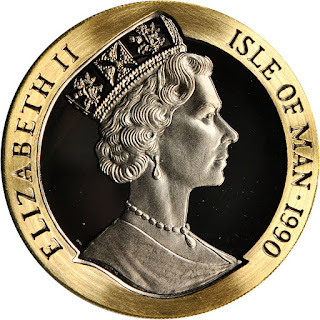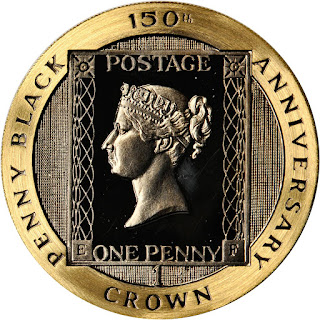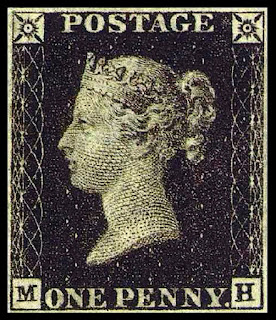Isle of Man Coins 1 Crown Gold Coin 1996 Penny Black
Commemorative issue: 150th Anniversary of "Penny Black" Stamp
The Penny Black is one of the world’s most iconic stamps. Because it’s the world’s first stamp, it’s very valuable.
Obverse: Crowned bust of Queen Elizabeth II right
Lettering: ELIZABETH II ISLE OF MAN · 1990 RM
Engraver: Raphael David Maklouf
Reverse: Crowned head of Queen Victoria left within stamp
Lettering: PENNY BLACK 150th ANNIVERSARY POSTAGE E ONE PENNY F 1 CROWN
Engraver: William Wyon
Value 1 Crown = 0.25 Manx pound
Metal Gold (.999)
Weight 31.1 g
Diameter 38.61 mm
Shape Round
Penny Black
The Penny Black was the world's first adhesive postage stamp used in a public postal system. It was issued in Great Britain on 1 May 1840, for official use from 6 May of that year. It features a profile of Queen Victoria.
But before 1840, the post service was prohibitively expensive for most people to use. In fact the cost of sending a single letter could cost of much as a working man’s daily wage. Postage was charged by the sheet and the distance travelled. (This led to the habit of writing a letter, then turning the page upside down and writing the second page of the letter between the lines of the original – thus saving sheets as four pages of letter could be written on one piece of paper.) By contrast, the Penny Black allowed letters of up to half an ounce (14g) to be delivered at a flat rate, regardless of distance.
But cost was not the only issue. There were many oddities. Certain items of post went free of charge, newspapers could be sent very cheaply and most mail was paid for by the person receiving the mail, not the sender.
Postal reform ideas – James Chalmers
It’s not surprising then that for many years prior to 1840, there were calls for reform of the postal system. As early as 1822, James Chalmers, a bookseller and printer from Dundee, was interested in postal reform. Some say that he was the actual inventor of the adhesive postage stamp. He also advocated the introduction of standard prepaid letter folders, letter sheets or envelopes which were eventually introduced in 1840 using a design by William Mulready. He printed samples of his idea for printed gummed labels in August 1834.
James Chalmers Inventor of the Adhesive Postage Stamp edited by W.J. Smith, and published in Dundee in 1970 gives an account of James Chalmers’ activities in the area of postal reform.
Later reformers - Rowland Hill and Robert Wallace
Rowland Hill and Robert Wallace (Member of Parliament for Greenock) were notable campaigners. In 1837, Rowland Hill proposed the radical reform of wapping a letter in an additional piece of paper (now known as the envelope) and attaching a ‘label’ (now known as a stamp) to indicate prepayment of the postage charge.
Postal delivery systems using what may have been adhesive stamps existed before the Penny Black. The idea had at least been suggested earlier in Austria, Sweden, and possibly Greece.
Treasury competition
On 13 February 1837, Sir Rowland Hill proposed to a government enquiry both the idea of a pre-paid stamp and a pre-paid envelope, a separate sheet folded to form an enclosure for carrying letters. Hill was given a two-year contract to run the new system, and together with Henry Cole he announced a competition to design the new stamps. There were 2,600 entries but none was considered suitable; instead a rough design endorsed by Hill was chosen, featuring an easily recognisable profile of the 15-year-old former Princess Victoria. Hill believed this would be difficult to forge. An envelope bearing a reproduction of a design created by the artist William Mulready was also issued.
1839 Penny Postage Bill
Eventually, on 17 August 1839, Penny Postage Bill was passed by Parliament. The act required that the basic postal rate for simple letters should be set at one penny. It also required that prepayment should become the standard for sending letters and that prepayment should be indicated by ‘labels’. There labels were the Penny Black and the Twopence Blue. Like today, the stamps were cancelled by a cancellation stamp, although this mark was red rather than the black used today.
Design
The portrait of Victoria was engraved by Charles Heath and his son Frederick, based on a sketch provided by Henry Corbould. Corbould's sketch was in turn based on the 1834 cameo-like head by William Wyon, which was used on a medal to commemorate the Queen's visit to the City of London in 1837. This portrait of Victoria remained on British stamps until her death in 1901, although by then she was 81 years old. All British stamps still bear a portrait or silhouette of the monarch somewhere on the design. They are the only postage stamps in the world that do not show country of origin; the monarch's image symbolises the United Kingdom.
Initially, Hill specified that the stamps should be 3/4 inch square, but altered the dimensions to 3/4 inch wide by 7/8 inch tall (approx 19 x 22 mm) to accommodate the writing at the bottom. The word "POSTAGE" at the top of the design distinguishes it from a revenue stamp, which had long been used in the UK; "ONE PENNY." at the bottom shows the amount pre-paid for postage of the stamped letter. The background to the portrait consists of finely engraved engine turnings. The two upper corners hold Maltese crosses with radiant solar discs at their centres; the lower corner letters show the position of the stamp in the printed sheet, from "A A" at top left to "T L" at bottom right. The sheets, printed by Perkins Bacon, consisted of 240 stamps in 20 rows of 12 columns. One full sheet cost 240 pence or one pound; one row of 12 stamps cost a shilling. As the name suggests, the stamp was printed in black ink. A two penny stamp printed in blue and covering the double-letter rate (up to an ounce) was issued on 8 May 1840.
Issue
Although the stamps were not officially issued for sale until 6 May 1840, some offices such as those in Bath sold the stamps unofficially before that date. There are covers postmarked 2 May, and a single example is known on cover dated 1 May 1840. All London post offices received official supplies of the new stamps but other offices throughout the United Kingdom did not, continuing to accept payments for postage in cash for a period.
The Penny Black lasted less than a year. A red cancellation was hard to see on the black design and the red ink was easy to remove; both made it possible to re-use cancelled stamps. In February 1841, the Treasury switched to the Penny Red and began using black ink for cancellations, which was more effective and harder to remove. However, people still reused stamps by combining the uncancelled parts of two stamps to form an unused whole, so in 1864 as a further safeguard the top corner stars on the Penny Red were replaced by the lower corner check letters in reverse order.
Imprimatur sheet
Imprimaturs are the first stamps printed from an approved and finished printing plate. In the 19th century, it was common for officials to remove some stamps from each sheet to present as gifts to dignitaries and other important people. Despite this, a complete imprimatur sheet of the Penny Black, without check letters, is held by the British Postal Museum.
Printing
The Penny Black was printed from 11 plates, but as Plate 1 was completely overhauled due to excessive wear, it is generally considered to be two separate plates, 1a and 1b. Plate 11 was originally intended solely for the printing of new red stamps, but a small number were printed in black. These are scarce.
The stamps were printed in unperforated sheets, to be cut with scissors for sale and use.
An original printing press for the Penny Black, the "D" cylinder press invented by Jacob Perkins and patented in 1819, is on display at the British Library in London.
Penny Black Stamps Price Guide
Rarity
The only known complete sheets of the Penny Black are owned by the British Postal Museum. Generally, the Penny Black stamp is not a rare stamp. The total print run from all the Penny Black plates was 286,700 sheets (each sheet contained 240 unperforated stamps). This meant that sixty eight million Penny Black Stamps were issued (68,158,080 to be precise). Assuming a survival rate of two percent, there are likely to be about 1.3 million still in existence. However, the survival rate may be considerably more than two percent.
The reason for the good survival rate is because in Victorian times, envelopes were an exception rather than the rule. Instead the letter was folded and sealed with sealing wax with the stamp being stuck on the outside of the folded letter. Today the envelope and stamp is thrown away and the letter kept, but in Victorian times the letter together with the stamp was kept. This applied to legal and business correspondence as well as personal letters. For years, Penny Black stamps lay safely hidden in the filing cabinets of banks and solicitors all over the country. When the cabinets were eventually emptied many years later, the value of Penny Black stamps was already appreciated and many were sold as collectors items.
Factors determining value
The value of a Penny Black Stamp depends on three factors:
1. The physical condition of the stamp
2. The plate used to print the stamp
3. The appearance of the white margins
The physical condition – faults in the condition of the stamp such as thinning, tears, creases or stains will lower the value.
The plate used to print the stamp - some plates are rarer than others. The rarest is plate 11.
The appearance of the margins – Penny Blacks were not perforated and the seller had to cut out the stamps from the sheet using scissors or a knife. There was only about 1mm between the stamps and it was not unusual to accidentally cut into the printed section of the stamp, resulting in irregular margins. The number, size, and regularity of the margins make all contribute to the value of the Penny Black stamp.
For example, a Penny Black with two full margins and a reasonable amount of the other two margins is regarded as an average specimen. Stamps with four, regular margins are exceptional, and collectors will pay higher prices for these stamps.
Penny Black Prices
How much is a Penny Black stamp worth? In 2008, a Penny Black in poor condition can cost as little as £15. A reasonable looking Penny Black will cost you £25. A better quality specimen might cost £60 to £100. A stamp with unusual attributes can cost up to £250. Mint examples are considerably more valuable – expect to pay anything from £1800 upwards. By contrast, a used Penny Red can cost as little as £1.50.
Penny Black stamps sold in presentation folders, with certificates of authenticity tend to be priced at well above market rates.


